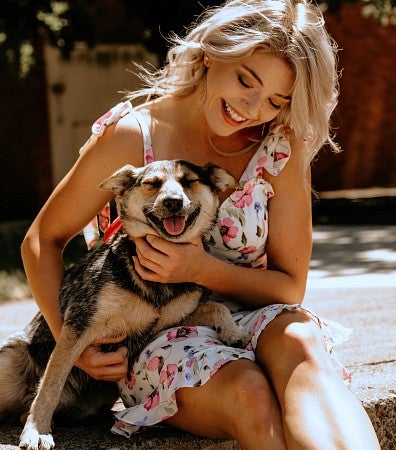
In a senior-year assignment for Environmental Studies 411: Multispecies Studies and the Anthropocene, Katelyn Swarringim, BS ’20 (environmental studies), wrote a paper reflecting on her relationship with Miley, her blue heeler puppy. She derived this essay from that piece.
If I’ve noticed one thing about my deaf dog Miley, it’s this: other dogs tend to treat her normally. People, on the other hand, react quite differently.
I have experienced insensitivity from people suggesting that Miley is incapable because they don’t understand that it’s still possible for us to communicate. People often say they feel sorry for her or ask me how I handle having a dog with a disability. I have to remind them that Miley doesn’t know any different and that her deafness is not a burden unless it is treated as such. Miley is happy and healthy and was born without her hearing, so it is just a part of our reality. Her deafness is not an inconvenience for her or me; it just changes the way that we do things.
In fact, because of Miley’s hearing disability, I have really begun to value the relationship that we have developed. Donna Haraway describes this kind of companionship in her book When Species Meet. Haraway explains that companion species not only develop a bond but they change one another. Miley and I have changed each other through our companionship. Her deafness simply influences the way we interact.
Miley is often nervous in new places or situations; she knows that when I put her harness on she is going to go somewhere outside the safety of our yard. She communicates this by putting her ears back and avoiding eye contact with me. But the more places I have taken Miley, the more she has become conditioned to new environments, and the more comfortable she has become with leaving the yard.
Miley often barks at me when she wants her food or wants me to play ball. Many people are surprised that deaf dogs bark but Miley understands that this instinctive behavior gets my attention.
Originally, one of the tools I used in training was a vibrating collar that got her attention when she wasn’t looking at me. I have taught her several hand signals for the commands “sit,” “stay,” “come,” and my favorite—“look at me,” where she looks me in the eyes (too cute).
Heelers are often good at interpreting body language as well as facial expressions. I know Miley understands when I am happy or upset with her because of the way she responds to my body language and expressions. For example, when I am sad about something my body language is different; Miley can sense this and reacts by licking my face and climbing into my lap.
I still really struggle with getting Miley’s attention when she is not looking at me, as well as when she chooses to ignore my hand-signal commands. Getting Miley’s attention will always be a challenge and at times I find myself frustrated with the way our training is going. I have to remind myself that it will be a lifelong process and not something that happens overnight.
Miley has definitely changed me as a person and has transformed my life for the better. I am grateful for the lessons and patience she teaches me daily.
More, Miley has boosted my overall mental health—every day she does something that makes me smile and laugh.
Katelyn Swarringim, BS ’20 (environmental studies), plans to work in sustainable transportation and infrastructure. She and Miley continue to hike wilderness areas across the state.

